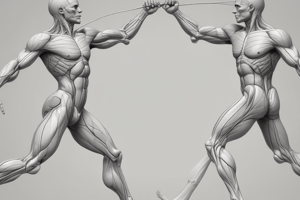Podcast
Questions and Answers
What is the primary function of the rotatores muscles?
What is the primary function of the rotatores muscles?
- Extending the spine beyond its normal range.
- Supporting stability and facilitating rotational movements. (correct)
- Enhancing flexibility in the thoracic region.
- Strengthening the deep stabilizing muscles around the abdomen.
Which muscle is particularly vital for maintaining proper spinal alignment?
Which muscle is particularly vital for maintaining proper spinal alignment?
- Erector spinae
- Multifidus (correct)
- Semispinalis
- Rotatores
What action does hyperextension primarily involve?
What action does hyperextension primarily involve?
- Rotating the trunk towards the opposite side.
- Straightening body parts from a flexed position.
- Extending joints beyond their normal range. (correct)
- Flexing joints to a normal range.
What role do the semispinalis muscles play in the body?
What role do the semispinalis muscles play in the body?
Which of the following actions significantly benefits from rotational mobility provided by neck and trunk rotation?
Which of the following actions significantly benefits from rotational mobility provided by neck and trunk rotation?
What is the primary role of the multifidus muscle?
What is the primary role of the multifidus muscle?
Which muscle is primarily responsible for assisting in spinal rotation?
Which muscle is primarily responsible for assisting in spinal rotation?
What common action is associated with the semispinalis muscle group?
What common action is associated with the semispinalis muscle group?
In which regions are the rotatores muscles predominantly active?
In which regions are the rotatores muscles predominantly active?
Which of the following statements is true regarding the common actions of these deep layer muscles?
Which of the following statements is true regarding the common actions of these deep layer muscles?
Flashcards are hidden until you start studying
Study Notes
Deep Layer Muscle Structure
- Semispinalis: Located in the posterior neck and upper thorax; divided into three parts: thoracis, cervicis, and capitis. Essential for head and trunk extension and rotation.
- Multifidus: A significant stabilizing muscle extending from the sacrum to the cervical spine; vital for posture and spine stability.
- Rotatores: Short muscles situated between adjacent vertebrae; primarily assist in rotation of the spine and maintain its stability.
Common Actions
- Extension: Involves straightening body parts away from a flexed position, notably affecting head, neck, and trunk movements.
- Hyperextension: Extension of a joint beyond its normal range, particularly important in neck and back movements.
- Rotation: Neck and trunk can rotate toward the opposite side, enhancing mobility and flexibility for daily activities.
Muscle Specifics
- Rotatores: Function mainly in the lumbar and cervical regions, providing stability and aiding in rotational movements of the spine.
- Multifidus: Active primarily in the lumbar and cervical regions; critical for maintaining spinal alignment and reducing injury risk when engaging in movement.
- Semispinalis: Important in thoracic, cervical, and capitis areas, supporting and facilitating head and trunk movements while also helping in maintaining proper posture.
Studying That Suits You
Use AI to generate personalized quizzes and flashcards to suit your learning preferences.



